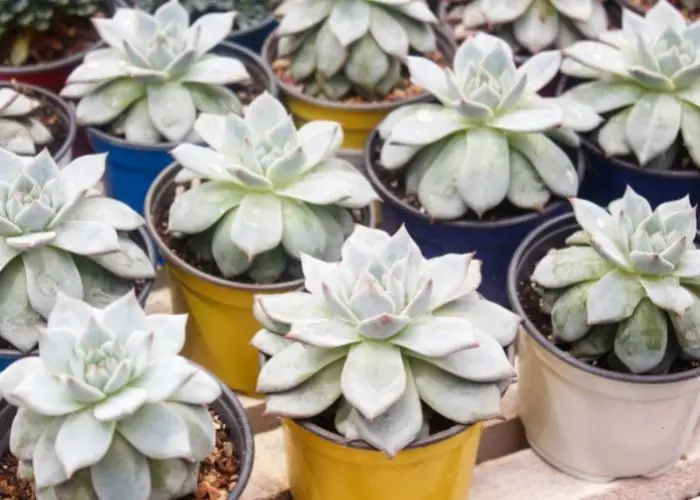You can prune sedums in either the winter or the spring. Learn about the pros and cons of each and when to prune.
Sedums that grow along the edges of your garden should be cut down every year when their growing season is over. There are gardeners who think it’s better to wait to cut back until spring, while others do this job before winter.
Sedum is a very broad genus that includes the full range of perennial, biennial, and annual plants. Some are very low-growing ground cover plants, while others are taller border sedums, which are now called Hylotelephium but are still called sedum by many gardeners. All types of sedum are much-loved for being drought tolerant and simple to maintain.
When we talk about when to cut back sedum for the winter, we’re talking about the taller, upright sedums that are common in flower beds and borders. We take a look at why, when, and how you should complete this simple, but important, gardening task.
With their succulent leaves and colorful blooms, sedums are popular perennials for flowerbeds, rock gardens, and containers. Also called stonecrops, these drought-tolerant succulents come in a huge range of heights, forms, and colors
Many gardeners wonder about the best time for cutting back sedum plants. While sedums don’t require pruning to thrive, cutting them back at strategic times can promote bushier, more compact growth and fuller blooming.
Read on to learn all about when and how to cut back sedum plants for optimal health and performance
Why Prune Sedum Plants?
Sedums are typically low maintenance perennials. Most varieties tolerate poor soil, heat, and drought once established. Minimal care is needed beyond occasional watering and fertilizing.
But sedums do become floppy and sparse as they finish flowering in late summer and fall. Stems collapse under the weight of spent blooms. This can leave plants looking unsightly.
Pruning off old flower heads improves appearance. Cutting back stems encourages the plants to branch out. This results in shorter, bushier sedums with more blooms.
Cutting back overgrown sedums controls size. Pruning also rejuvenates old plants by stimulating new growth. Damaged or diseased stems can be removed as needed.
When is the Best Time to Prune Sedum?
Timing is important when cutting back sedum plants. You want to promote new growth and blooms, not inadvertently remove next season’s flower buds.
Here are some guidelines for optimal timing:
-
Spring – In early spring, remove any remaining dead foliage and spent blooms by cutting stems back to the fresh growth emerging at the base.
-
Early Summer – For fuller, shorter plants that bloom later, cut back by 1/2 to 2/3 in early summer before buds form. This stimulates branching.
-
Mid to Late Summer – Pruning too late in summer risks removing flower buds. But you can still snip back overly long or floppy stems.
-
Fall – Cut plants back to the ground after a killing frost. Or leave seed heads for winter interest and prune in spring.
-
Winter – Avoid pruning when plants are dormant. Wait until spring growth resumes.
The exact timing depends on your climate and the variety grown. But focus on pruning sedums in spring through mid-summer to shape plants without sacrificing flowers.
How to Trim Sedum Plants
Pruning sedum plants is simple. No special tools or techniques are required. Follow these tips:
Remove Spent Blooms
- Old, dried out sedum flower heads can be snapped off by hand anytime to improve appearance.
Cut Back Stems
-
Use clean, sharp bypass hand pruners or scissors. Sterilize tools in diluted bleach between plants.
-
Remove stems back to the base rosette or to lateral buds to encourage bushy regrowth.
-
Don’t prune stems lower than the basal foliage. Leaving some leaves preserves growth.
Prune Entire Plants
-
Alternatively, cut back the entire plant to 1-3″ above ground level to rejuvenate overgrown sedums.
-
New shoots will quickly sprout from the crown. Flowers will be reduced the first year after dramatic pruning.
Clean Up Pruning Debris
-
Pick up and dispose of any cut stems and debris to prevent pests and disease.
-
Dip tool blades in rubbing alcohol and wipe clean between plants.
Proper sanitation when pruning sedums prevents the spread of fungal diseases like stem rot. Always sterilize tools prior to use.
Tips for Cutting Back Specific Sedum Varieties
While techniques are similar for all sedum varieties, the timing and degree of pruning may vary by type.
Here are some specific tips:
-
Sedum spectabile – Cut back to 6″ in early summer to control height and flowering time. Deadhead in fall or leave seed heads for winter.
-
Sedum spurium – Shear mat-forming types by 1/3 to 1/2 in early summer to renew growth. Prune again after blooming ceases.
-
Sedum acre – Cut back trailing gold sedums in spring to tidy growth. Pinch through summer to prevent lodging and open up air circulation.
-
Sedum ternatum – Prune lightly in early spring to remove winter damage on low-growing groundcover types. Avoid cutting into healthy green tissue.
-
Sedum album – Cut back upright varieties like white stonecrop by half in early summer to generate a bushy habit and delay bloom time.
Get to know the growth habit and bloom time of the sedums in your garden. Then you can tailor pruning to shape them as desired without sacrificing flowers.
Caring for Sedums After Pruning
Providing proper care after cutting back sedum plants encourages quick regrowth. Here are some tips:
-
Water thoroughly after major pruning to help plants recover. Then resume a normal watering routine.
-
Apply a balanced fertilizer or slow-release granular fertilizer in early spring to fuel growth.
-
Watch for signs of disease like stem rot in cut areas. Remove any diseased bits and improve air circulation.
-
Stake tall sedums like Autumn Joy if stems seem weak after pruning. Remove stakes once plants regain structure.
-
Deadhead spent blooms through the season to encourage extended flowering and tidier plants.
With a little attention to their needs, sedums will flourish. The improved form and mass of blooms following judicious pruning will be well worth it.
Problems to Watch For When Pruning Sedums
Sedums are generally easy to prune, but here are a few potential issues to avoid:
-
Removing too much growth starves plants of needed food reserves from leaves and stems. Avoid cutting sedums back to the bone.
-
Overpruning can strip away next season’s flower buds, reducing blooms. Always leave some lateral buds intact.
-
Cutting into thick, succulent foliage creates entryways for disease. Make clean cuts just above leaf nodes without damaging leaves.
-
Not sterilizing tools allows bacteria and fungi to travel from plant to plant. Always sanitize pruners before moving between plants.
-
Leaving cutting debris in place invites pests and rot. Promptly dispose of all pruned stems and dead leaves.
-
Pruning late in the year takes away food storage plants need to survive winter. Finish pruning sedums by early fall at the latest.
With careful sterile pruning and attention to timing, you can avoid most problems. Healthy, vigorous sedum plants will result.
Frequently Asked Questions About Pruning Sedum
If you’re new to growing and pruning sedum plants, here are answers to some common questions:
Do all sedum varieties need pruning?
Not necessarily. Low growing sedums like dragon’s blood or mossy stonecrop don’t require pruning. But larger, upright varieties benefit from cutting back to control flopping and improve density.
Should I cut back sedum in the fall?
No, fall pruning is too late. You risk removing flower buds forming for next year. Only prune in fall to remove spent blooms or tidy damaged growth. Cut plants back fully in early spring.
Can I divide sedum plants when pruning them?
Yes! Spring or early summer is an ideal time to divide congested sedum clumps. Gently pry sections apart with roots attached to create new plants. Prune remaining stems back by half.
How much can I cut back sedum without harming the plant?
Most varieties tolerate pruning stems back by 50% to two-thirds without consequence. Cutting sedums back to 1 to 3 inches from the ground rejuvenates overgrown plants. Just avoid removing all growth down to the soil line.
Do I need to deadhead spent sedum flowers?
Deadheading isn’t mandatory but it improves the look. Snip off old flower heads as they fade to encourage reblooming. Leave some for winter interest if desired.
Revive Sedums With Proper Pruning
With their low-care nature and longevity, sedums are excellent perennial garden plants. But their appearance can suffer after years of growth and blooming.
Strategically pruning back sedums at the right time of year revives them. Cutting back stems and flower heads maintains a tidy form, encourages dense regrowth, and promotes prolific reblooming.
Just be sure to prune sedums at the optimal time for your variety. Sterilize tools properly between plants. And avoid overpruning that can starve plants. With a little diligent pruning, your sedums will thrive for years to come.
How to cut back sedum for winter
Trimming back sedum is a simple and quick fall gardening job that requires only minimal tools to complete. You should only need a clean, sharp pair of pruning shears and a wheelbarrow or bucket to clean up any mess.
Lindsey Hyland, founder of Urban Organic Yield, always says to make sure that garden tools are clean and sharp so that you can “make precise cuts without harming the plant.” Don’t make the pruning mistake of cutting plants with dull or dirty tools.
“Prune the stems to a height of two to three inches above the ground,” she says about how to cut back sedum crops. Additionally, you can leave some stems unbroken for wildlife habitats and winter interest.
“Get rid of the cut stems and leaves to keep disease or pests from spending the winter in the garden.” ’.
After sedums have been cut back, they can use a little extra care to help them stay safe over the winter.
Tammy Sons from TN Nursery says: ‘Is it beneficial to feed or mulch sedums after cutting them back? We mulch them. Simply mulching them gives the plants a great boost.’
Adding a layer of two to three inches of mulch, like compost, well-rotted manure, or leaf mold, can help protect the plant roots from the harsh winter weather. If you mulch your flower beds, the crushed rock will help the soil stay healthy and hold its shape.

Lindsey Hyland grew up in Arizona, where she attended the University of Arizona’s Controlled Environment Agriculture. In addition to her formal education, she has worked on several organic farms and spent a semester studying abroad in India. She is sharing everything on her gardening journey at UrbanOrganicYield. com to turn your gardening adventure into a lifelong passion.

Tennessee Wholesale Nursery is owned by Tammy Sons. It is a third-generation family business in Tennessee that grows a wide range of trees, shrubs, flowers, and other plants. Felco Pruning Shears (F 6).
You can trim sedum and do other small pruning jobs in the back yard with this high-quality pair of bypass pruning shears. With forged aluminum handles and hardened steel blades, the Felco Pruning Shears will last for many years.
When to cut back sedum for winter
The ideal time to cut back sedum for winter will be dependent on your climate. Don’t go out and trim back the plants until after the first frost. Put it on your list of things to do for fall gardening. This will usually be in late fall or early winter.
Any flowers that are still alive will be killed by the first hard frost, and the sedum will then go into winter dormancy. It is best to wait until that first frost. If you cut back too early in the fall, before the plant has gone into dormancy, you might cause new growth that will be damaged by frosts, and it might also make the plant less hardy overall.
Wait until after the first frost to cut back sedums for winter( credit: Getty s/Oksana_Schmidt)
How to Cut Back Sedum Autumn Joy and other Perennials – In WINTER OR SPRING!
- The Ultimate Guide to Growing Strawberries in Raised Beds - August 8, 2025
- No-Dig Garden Beds: The Easiest Way to Grow a Beautiful Garden - August 6, 2025
- How to Protect and Preserve Wood for Raised Garden Beds - August 6, 2025

